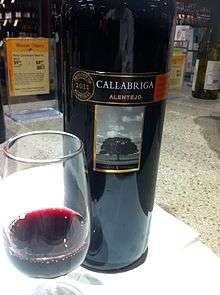Alicante Bouschet
| Alicante Bouschet | |
|---|---|
| Grape (Vitis) | |
 Alicante Bouschet in Viala & Vermorel | |
| Color of berry skin | Noir |
| Species | Vitis vinifera |
| Also called | Alicante Henri Bouschet, Garnacha Tintorera |
| Origin | France |
| Notable regions | Alentejo, California |
| Hazards | Downy mildew |
Alicante Bouschet or Alicante Henri Bouschet is a wine grape variety that has been widely cultivated since 1866. It is a cross of Petit Bouschet (itself a cross of the very old variety Teinturier du Cher and Aramon) and Grenache.[1] Alicante is a teinturier, a grape with red flesh. It is one of the few teinturier grapes that belong to the Vitis vinifera species. Its deep color makes it useful for blending with light red wine. It was planted heavily during Prohibition in California for export to the East Coast. Its thick skin made it resistant to rot during the transportation process. The intense red color was also helpful for stretching the wine during prohibition, as it could be diluted without detracting from the appearance. At the turn of the 21st century, Alicante Bouschet was the 12th most planted red wine grape in France with sizable plantings in the Languedoc, Provence and Cognac regions.[2]
History and breeding
The grape was first cultivated in France in 1866 by Henri Bouschet as a cross of Petit Bouschet and Grenache. The Petit Bouschet grape was created by his father Louis Bouschet. The result was to produce a grape with deep color grape of higher quality than the Teinturier du Cher. Several varieties of Alicante Bouschet were produced of varying quality. The grape's high yields and easy maintenance encouraged its popularity among French wine growers, especially in the years following the Phylloxera epidemic. By the end of the 19th century there were Alicante Bouschet plantings in Bordeaux, Burgundy, Loire Valley and Alentejo, Portugal
The grape was widely popular in the United States during the years of Prohibition. Grape growers in California's Central Valley found that its pulp was so fleshy and juicy that fermentable juice could be retrieved even after the third pressing. In contrast, wines made from grapes like Chardonnay and Merlot typically only include the juice from the free run (before pressing) and first or second pressing. The grape's thick skin also meant that it could survive the long railway transportation from California to New York's Pennsylvania Station which had auction rooms where the grapes were sold. In 1928, one single auction lot of 225 carloads of grapes were purchased by a single buyer. The amount of grapes was enough to make more than 2,000,000 US gallons (7,600,000 L) of wine.[3]
Wine regions

In France, the grape was historically a blending partner with Aramon but in recent times has been made more into its own varietal. However, planting of new vines has steadily declined. In some areas of France the grape is now extinct. According to international wine guru and Master of Wine, Jancis Robinson, Alicante Bouschet is thought to have found its true home in Portugal's Alentejo where it was first planted at Herdade do Mouchão in the 1890s. Widely planted across the Alentejo wine region today (having grown exponentially in popularity from the late 1990s) it is frequently expensive. These top-end wines are prized for their 'size', dense colour and phenolic content. In Chile the grape is blended with Cabernet Sauvignon and to make concentrated varietal wines. In California the grape was popular among home winemakers during Prohibition and still grown today in Napa, Sonoma and Madera counties. Other areas with notable Alicante Bouschet plantings include Algeria, Israel and parts of central and southern Italy.[4]
Viticulture and wine

The grape is known for its deep dark color, more than 15 times the color of Aramon and twice the darkness of the Grand Noir de la Calmette. The grape produces high yields, an average of 80 hl/ha. It buds and ripens early to produce wines often with alcohol levels around 12%. The wines produced by the grape alone typically aren't of the highest quality and tend to be flabby, lacking character and complexity. The grape vine is prone to grape diseases like anthracnose and downy mildew.[5] The grape leaves of the vine are unique in that they have patches of purple coloring.[2]
Synonyms
Alicante Bouschet is also known under the synonyms Alicant de Pays, Alicante, Alicante Bouchet, Alicante Bouschet 2, Alicante Extra Fertile, Alicante Femminello, Alicante H. Boushet, Alicante Henri Bouschet, Alicante Nero, Alicante Noir, Alicante Tinto, Alicantina, Alikant Buse, Alikant Buse Bojadiser, Alikant Bushe, Alikant Bushe Ekstrafertil, Alikant Bushe Nr. 2, Alikant Genri Bushe, Alikante Henri Bouschet, Aragonais, Aragones, Arrenaou, Baga, Bakir Uezuemue, Barvarica, Blasco, Bojadiserka, Carignan Jaune, Cupper Grape, Dalmatinka, Garnacha, Garnacha Tintorera, Lhadoner, Kambuša, Moraton, Mouraton, Murviedro, Negral, Pe de Perdiz, Pe de Pombo, Petit Bouschet, Redondal, Rivesaltes, Rivos Altos, Roussillon, Rouvaillard, Sumo Tinto, Tinta Fina, Tinta Francesa, Tinto, Tinto Nero, Tinto Velasco, Tintorera, Tintorera de Liria, Tintorera de Longares, Tinturao, and Uva di Spagna.[1]
Crosses
Alibernet - crossing of Alicante Bouschet x Cabernet Sauvignon was bred in 1950 in the Ukrainian Scientific Research Institute for Wine and Vines in Odessa. It is planted in Slovakia, Hungary and the Czech Republic.
See also
References
- 1 2 Alicante Henri Bouschet, Vitis International Variety Catalogue, accessed on June 26, 2010
- 1 2 J. Robinson (ed) "The Oxford Companion to Wine" Third Edition pg 13 Oxford University Press 2006 ISBN 0-19-860990-6
- ↑ H. Johnson Vintage: The Story of Wine pg 444 Simon and Schuster 1989 ISBN 0-671-68702-6
- ↑ Oz Clarke Encyclopedia of Grapes pg 35 Harcourt Books 2001 ISBN 0-15-100714-4
- ↑ J. Robinson Vines, Grapes & Wines pg 206 Mitchell Beazley 1986 ISBN 1-85732-999-6
External links
- Appellation America Alicante Bouschet
- An amateur grower's view